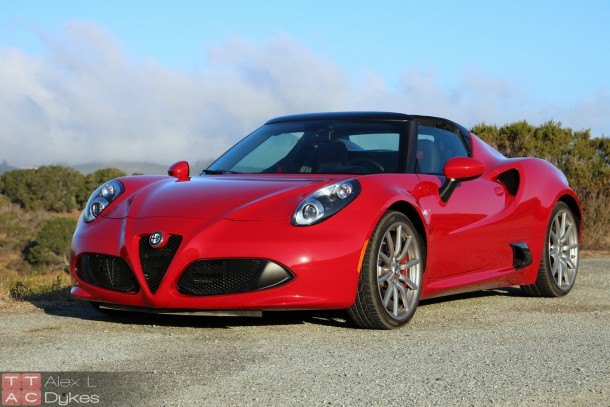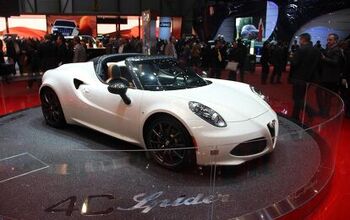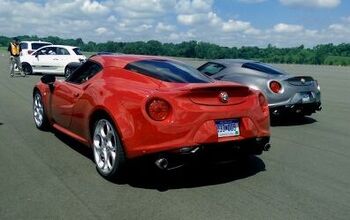2016 Alfa Romeo 4C Spider Review (With Video)

2016 Alfa Romeo 4C Spider
1.75-liter DOHC I-4, direct injection, turbocharged, CVVT (237 horsepower @ 6,000 rpm; 258 lbs-ft @ 2,200-4,250 rpm)
6-speed “Alfa TCT” dual-clutch automatic
24 city/34 highway/28 combined (EPA Rating, MPG)
28.1 (Observed, MPG)
Tested Options: Rosso Alfa Red paint, Fascia Stone Protector, HID Headlamps, Carbon Fibre Trim Kit, Convenience Package, Racing Exhaust, Red Calipers, 18/19 Inch Staggered Wheels, Leather Package,
Base Price:
* Prices include $1,595 destination charge.
Up ’til now, if you wanted an Italian, mid-engined, street-legal track roadster made out of exotic materials, you needed to be a one-percenter to afford one. But all that is changing with the relaunch of the “other Italian brand,” Alfa Romeo. For the price of a single black-market organ “donation” you can get your hands on the new 2016 Alfa Romeo 4C Spider. Unlike Alfa’s last car sold in America — the Alfa Romeo 8C Competizione — the 4C Spider is pronounceable, will be available in quantity, and is ostensibly attainable at $53,900 for the coupé and $63,900 for the rag top that we got our hands on.
Like the hardtop 4C, this exotic isn’t an enormous bruiser that’s as wide as Kansas, and it doesn’t have a V12. Instead Alfa opted for a small four-cylinder turbocharged engine and a serious dedication to lightweight construction. In some ways you might call this the Italian Lotus. Until we see the 2017 Alfa Romeo Guilia, FCA’s 3-Series fighter, the 4C and 4C Spider are spearheading the brand’s American reboot.
Is that good or bad?
Exterior
If you couldn’t tell by the pictures, this Alfa is very small for a modern mid-engined Italian. At 157.5 inches long, the Alfa slots between the current 2-door and 4-door MINI Cooper. That’s two feet shorter than a Ferrari 488 Spider. It’s also very low to the ground with a roof height measuring in right around four feet.
Going topless almost always adds weight. However, the 4C’s carbon fibre monocoque comes to the rescue of ragtop performance lovers. Despite structural changes that had to be made, the Spider is just 22 pounds heavier than the coupé. The reason is largely because the chassis was designed for topless motoring from the start. Because the carbon fibre tub is so rigid, little additional structure needed to be added for the Spider model. In addition, some weight was saved by giving the Spider a plastic rear hatch and not the glass and plastic version we see in the hard top.
Our tester carried a manufacturer estimated curb weight of 2,487 pounds, 342 pounds heavier than the European model, but still anorexic by American standards. The weight difference is found in a thicker carbon fibre tub, required side impact airbags, standard air conditioning, an adjustable passenger seat and the EPA’s requirement that curb weight be based on options that have at least a 33-percent take rate. In reality, the difference between a similarly configured Euro and American model is smaller than that 342 pounds because of the way the numbers are calculated. That said, make no mistake the American 4C has scarfed down a few more meatballs than its Italian cousin. The astute in the crowd will note this is actually 195 pounds heavier than a new Mazda MX-5. The weight difference is likely due to the mid-engine design, turbocharger and plumbing, larger brakes, wider tires and stouter cooling system. Fear not, the 4C still makes the Porsche Cayman seem like a pig at 2,955 pounds.
Interior
Minimalist is the best way to describe the rest of the interior. The leather dashboard our model wore is optional but a worthy upgrade as it does improve the look of the cabin considerably. Aside from the snazzy dash there is little traditional luxury going on and that saves weight. Alfa even ditches the traditional glove compartment for a small square compartment behind and between the seats that is just large enough for a wallet and Rubik’s cube.
That also applies to the trunk. Unlike the Tesla or Porsche models, the 4C does not sport a “frunk.” What looks like a hood in the 4C is screwed into place in order to save weight. That means the small rear trunk aft of the engine is your only option. Featuring a prop rod rather than heavier struts, the rear lid serves as engine cover and trunk lid. The cargo well is big enough to fit a fat 24-inch roller bag (maximum size for domestic carry-on) and the tire inflator. That’s it. You should know two things about this. First, your luggage can get a bit toasty back there, so don’t put a case of fancy chocolates in the back unless you want them melted. Second, with a single bag in the back, there is no place to put the top when you take it off, other than handing it to your passenger. Thankfully the canvas top is small and light, but because the 4C’s cabin is so small it felt like there was a third person in the car with us. On the bright side, with the top off, the 4C is so loud I could not hear the complaints from my navigator.
Infotainment
Drivetrain
The lag would be a problem in a heavier car, or a car with fewer charms, but in the 4C the 6-speed dual clutch transaxle keeps the engine in the right rev range and the Race mode allows quicker starts. The Alfa 6-speed “TCT” is actually related to what we find in the Dodge Dart and other Fiat Chrysler front-wheel-drive cars. Internally, there are essentially two manual transmissions, one handles the even gears and the other does the odds. Switching from one gear to the other is a simple matter of releasing one clutch while engaging the other, making this type of transmission lightning fast compared to a traditional automatic. For 4C duty, Alfa fiddled with the gear ratios, rotated it 180 degrees from its usual applications and jammed it behind the seats.
At this time there’s just the one engine, although there are plenty of rumors about a 2.0-liter turbo. However, you can select from three different exhaust systems. The base system has a teeny-tiny muffler and it is fairly loud in its own right. Then there’s the optional $500 “Sport exhaust” that our model had. Sport exhaust is a bit of a stretch to be honest since what you’re really doing is paying $500 to have the muffler removed. That’s right, our 4C had no muffler. No resonator. No exhaust valves. Exhaust just passes from the engine to the turbo to the catalytic converter and then straight out the pipes. Available later will be a dynamic exhaust system from Akrapovič which should offer you the ability to be loud when you want and a little more sedate when you need it.
Drive
If you’ve never driven a car without power steering, it will be hard to explain what’s going on in the 4C. You should just visit the Alfa dealer and try one for yourself. For the rest of us this is almost a window in time. Although the standard 205/45R17 front tires may not sound terribly wide, parallel parking maneuvers require some upper body strength. (Hoping in my Jeep with its overboosted steering made me feel like a wimp.) The front rubber can be that narrow because just 41 percent of the car’s weight sits on the front axle, giving the Alfa a Porsche-like weight balance. The key thing to know is that the steering wheel diameter is small and the rack takes just 2.7 turns to go from one bump stop to the other. The quick ratio and small wheel take some getting used to on the highway where the light front gives the car a go-kart like eagerness to turn in. Alfa’s steering rack and front suspension combine to give you quite simply the best steering feel on a new car in America. Unlike a modern Porsche or BMW with power steering, you can actually feel what the car is doing. Also different than basically every other car on the market, this steering wheel fights back. If you check out the embedded video, in the drive section you can see how much motion is coming back through the steering rack when driven on a less-than-perfect mountain road. The difference is stark when driven back to back. The Alfa makes a Porsche’s steering rack feel numb and lazy. Bottom line: steering feel nerds will have a cargasm.
As stiff as the 4C’s suspension is, it rarely felt upset on broken pavement, something that could not be said of last week’s Mercedes GLA. Now, don’t confuse a well-sorted suspension design with a comfortable one. The 4C’s suspension is harsh. You can feel every bump in the road in the standard suspension tune, and opting for the track package and up-sized wheels (our model had the up-size wheels but not the track-tuned dampers) allows you feel every pebble in the road. The suspension is so stiff that the vibrations in the road actually made filming difficult. Couple that with thinly padded seats and you have a car designed for weekend motoring, not daily commuting. This is again a contrast from something like a Boxster or Cayman which are designed with daily-driving comforts in mind and an owner set that is more interested in knowing the car is track capable than actually taking their car on a track.
Perhaps the most impressive engineering feat of the 4C is the chassis stiffness. On the flip side, there is the reality that some chassis flex can help give a car a more forgiving ride. You’d think that the lightweight construction would yield better stopping distances. However, it actually takes a little longer to go from 60 to zero than most versions of the Corvette or the Cayman and Boxster thanks to the narrower tires on the Alfa.
At $72,295 for an almost fully-loaded 4C, the Alfa isn’t just a hoot and a half, it is almost a “deal.” Bargain hunters should also know that the rumor mill is saying 4C transaction prices have actually been below MSRP. Since Lotus can’t sell their wares on our shores at the moment, there is truly no direct competition. Even when Lotus returns in the 2017 model year with the $89,900 Evora 400, it still won’t be the same kind of car as the 4C. The Evora will weigh around 700 pounds more, have a V6 in the back and it appears to have a more luxurious and comfortable interior. Porsche doesn’t really offer a competitor despite having cars with a similar weight balance. Based on 0-60 times, the Porsche corollaries would be the $82,100 Boxster Spyder that’s 450 pounds heavier and the hard top Cayman GT4 at $84,600 and a little more than 500 pounds heavier.
The trouble is, neither of the Porsches is like the Alfa. Despite their performance mission, they can be had with 2-zone climate control, power seats, a garage door opener, touchscreen navigation, a six-disc CD changer, speakers loud enough to hear, an adaptive suspension and yes, even a muffler. It’s the fanatical dedication to slashing weight that makes the 4C such a compromise to live with, yet so endearing. The 4C is the first car I’ve met that bruises my kidneys yet had me coming back for more every time. (Of course, if I sold the kidney to buy the 4C then I wouldn’t have that problem anymore.)
The only trouble I see with the 4C is that, despite the fun-to-drive factor, the market for such a car is incredibly small. The fact that your rear end is skidding only 5 inches above the tarmac is another problem. Although I said this jokingly at the time, this may be my best summation: If you’re 30 years old, buy one. If you’re 40, you need to hurry. If you’re 50, you need to know there’s a chance you’ll get in but be unable to get back out when you reach your destination. TTAC tip: Get the Spider so Jeeves can lift you out.
Is the 4C practical? No. Is it worth it? Maybe not. Do I want one? Yes, but I have no idea why.
Alfa Romeo provided the vehicle, insurance and one tank of gas for this review
Specifications as tested
0-30: 1.7
0-60: 4.15
1/4 Mile: 12.6 @ 108

More by Alex L. Dykes
Latest Car Reviews
Read moreLatest Product Reviews
Read moreRecent Comments
- ToolGuy This thing here is interesting.For example, I can select "Historical" and "EV stock" and "Cars" and "USA" and see how many BEVs and PHEVs were on U.S. roads from 2010 to 2023."EV stock share" is also interesting. Or perhaps you prefer "EV sales share".If you are in the U.S., whatever you do, do not select "World" in the 'Region' dropdown. It might blow your small insular mind. 😉
- ToolGuy This podcast was pretty interesting. I listened to it this morning, and now I am commenting. Listened to the podcast, now commenting on the podcast. See how this works? LOL.
- VoGhost If you want this to succeed, enlarge the battery and make the vehicle in Spartanburg so you buyers get the $7,500 discount.
- Jeff Look at the the 65 and 66 Pontiacs some of the most beautiful and well made Pontiacs. 66 Olds Toronado and 67 Cadillac Eldorado were beautiful as well. Mercury had some really nice looking cars during the 60s as well. The 69 thru 72 Grand Prix were nice along with the first generation of Monte Carlo 70 thru 72. Midsize GM cars were nice as well.The 69s were still good but the cheapening started in 68. Even the 70s GMs were good but fit and finish took a dive especially the interiors with more plastics and more shared interiors.
- Proud2BUnion I typically recommend that no matter what make or model you purchase used, just assure that is HAS a prior salvage/rebuilt title. Best "Bang for your buck"!

























































































Comments
Join the conversation
Furthermore, this thing looks like the build quality is equivalent to the early dodge vipers in that it's basically an advanced kit car, minus the rip snorting v10. Is this seriously what the espresso swilling sweater thought was a good use of resources? Where is the Chrysler compact and crossover at? Why are they chasing such a low volume market that isn't going to make them any money at this retail level when they have Ferrari that makes them a boatload??
Ouch- full carbon construction and as sparten as an Elise, but still 200 pounds heavier than a Miata? What gives?